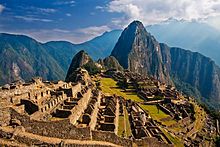Cross posted from The Stars Hollow Gazette
This is your morning Open Thread. Pour your favorite beverage and review the past and comment on the future.
Find the past “On This Day in History” here.
Click on images to enlarge
July 24 is the 205th day of the year (206th in leap years) in the Gregorian calendar. There are 160 days remaining until the end of the year.
 On this day in 1911, Machu Picchu discovered
On this day in 1911, Machu Picchu discovered
American archeologist Hiram Bingham gets his first look at Machu Picchu, an ancient Inca settlement in Peru that is now one of the world’s top tourist destinations.
Tucked away in the rocky countryside northwest of Cuzco, Machu Picchu is believed to have been a summer retreat for Inca leaders, whose civilization was virtually wiped out by Spanish invaders in the 16th century. For hundreds of years afterwards, its existence was a secret known only to the peasants living in the region. That all changed in the summer of 1911, when Bingham arrived with a small team of explorers to search for the famous “lost” cities of the Incas.
Traveling on foot and by mule, Bingham and his team made their way from Cuzco into the Urubamba Valley, where a local farmer told them of some ruins located at the top of a nearby mountain. The farmer called the mountain Machu Picchu, which meant “Old Peak” in the native Quechua language. The next day–July 24–after a tough climb to the mountain’s ridge in cold and drizzly weather, Bingham met a small group of peasants who showed him the rest of the way. Led by an 11-year-old boy, Bingham got his first glimpse of the intricate network of stone terraces marking the entrance to Machu Picchu.
 Machu Picchu was built around 1450, at the height of the Inca Empire. It was abandoned just over 100 years later, in 1572, as a belated result of the Spanish Conquest. It is possible that most of its inhabitants died from smallpox introduced by travelers before the Spanish conquistadors arrived in the area. The latter had notes of a place called Piccho, although there is no record of the Spanish having visited the remote city. The types of sacred rocks defaced by the conquistadors in other locations are untouched at Machu Picchu.
Machu Picchu was built around 1450, at the height of the Inca Empire. It was abandoned just over 100 years later, in 1572, as a belated result of the Spanish Conquest. It is possible that most of its inhabitants died from smallpox introduced by travelers before the Spanish conquistadors arrived in the area. The latter had notes of a place called Piccho, although there is no record of the Spanish having visited the remote city. The types of sacred rocks defaced by the conquistadors in other locations are untouched at Machu Picchu.
Hiram Bingham theorized that the complex was the traditional birthplace of the Incan “Virgins of the Suns”. More recent research by scholars such as John Howland Rowe and Richard Burger, has convinced most archaeologists that Machu Picchu was an estate of the Inca emperor Pachacuti. In addition, Johan Reinhard presented evidence that the site was selected because of its position relative to sacred landscape features such as its mountains, which are purported to be in alignment with key astronomical events important to the Incas.
Johan Reinhard believes Machu Picchu to be a sacred religious site. This theory stands mainly because of where Machu Picchu is located. Reinhard calls it “sacred geography” because the site is built on and around mountains that hold high religious importance in the Inca culture and in the previous culture that occupied the land. At the highest point of the mountain in which Machu Picchu was named after, there are “artificial platforms [and] these had a religious function, as is clear from the Inca ritual offerings found buried under them” (Reinhard 2007). These platforms also are found in other Incan religious sites. The site’s other stone structures have finely worked stones with niches and, from what the “Spaniards wrote about Inca sites, we know that these (types of) building(s) were of ritual significance” (Reinhard 2007). This would be the most convincing evidence that Reinhard points out because this type of stylistic stonework is only found at the religious sites so it would be natural that they would exist at this religious site. Another theory maintains that Machu Picchu was an Inca llaqta, a settlement built to control the economy of conquered regions. Yet another asserts that it may have been built as a prison for a select few who had committed heinous crimes against Inca society. An alternative theory is that it is an agricultural testing station. Different types of crops could be tested in the many different micro-climates afforded by the location and the terraces; these were not large enough to grow food on a large scale, but may have been used to determine what could grow where. Another theory suggests that the city was built as an abode for the deities, or for the coronation of kings
Although the citadel is located only about 80 kilometers (50 miles) from Cusco, the Inca capital, the Spanish never found it and consequently did not plunder or destroy it, as they did many other sites. Over the centuries, the surrounding jungle grew over much of the site, and few outsiders knew of its existence.






